Exploring Air Quality Dynamics and Predictive Modeling by Using Artificial Intelligence During COVID-19 Lock Down Over the Western Part of India
1
Department of Physics,
Sangam University,
Bhilwara,,
Rajasthan,
India
2
Department of Computer Science and Engineering,
Sangam University,
Bhilwara,,
Rajasthan,
India
Corresponding author Email: vikramsngh589@gmail.com
DOI: http://dx.doi.org/10.12944/CWE.19.2.36
Copy the following to cite this article:
Bhati V. S, Saxena A, Khatwal R. Exploring Air Quality Dynamics and Predictive Modeling by Using Artificial Intelligence During COVID-19 Lock Down Over the Western Part of India. Curr World Environ 2024;19(2). DOI:http://dx.doi.org/10.12944/CWE.19.2.36
Copy the following to cite this URL:
Bhati V. S, Saxena A, Khatwal R. Exploring Air Quality Dynamics and Predictive Modeling by Using Artificial Intelligence During COVID-19 Lock Down Over the Western Part of India. Curr World Environ 2024;19(2).
Download article (pdf) Citation Manager Publish History
Select type of program for download
| Endnote EndNote format (Mac & Win) | |
| Reference Manager Ris format (Win only) | |
| Procite Ris format (Win only) | |
| Medlars Format | |
| RefWorks Format RefWorks format (Mac & Win) | |
| BibTex Format BibTex format (Mac & Win) |
Article Publishing History
| Received: | 2024-04-08 |
|---|---|
| Accepted: | 2024-07-26 |
| Reviewed by: | 
 Sandeep Kumar
Sandeep Kumar
|
| Second Review by: |

 Aws Maseer Nejres
Aws Maseer Nejres
|
| Final Approval by: | Dr. R K Aggarwal |
Introduction
Air pollution is the biggest climate change issue nowadays, and predicting air quality helps to warn and control pollution. The nitrogen oxide (NOX) and air quality index (AQI) levels were estimated over Beijing and Italy using random forest regression (RFR)

Haze, consisting of ammonium compounds, obscures natural landscapes and reduces their aesthetic value. The transformation of ammonia into these substances can lead to acid rain, which can harm plants, aquatic ecosystems, and structures. The burning of fossil fuels and industrial processes are primary sources of sulfur dioxide emissions into the atmosphere, resulting from the reaction of ozone and hydroxyl radicals (OH). While HSO3 is being oxidized, sulfur trioxide is released. This reacts with water (H2O) to make the acidic compound H2SO4.
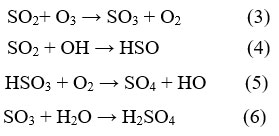
Surface ozone (O3) is generated by two main processes: stratospheric intrusion and in-situ photochemical decay of carbon-linked molecules (such as CO, CH4, and Volatile organic compounds) in the existence of NOx30. Mechanism of Ozone (O3) production from following reaction

The primary sources of O3 precursor gases include biomass combustion, fossil fuel combustion, and several other human activities. The photochemical reaction of precursor gases i.e., nitrogen oxides (NOx) forms Ozone (O3) in the troposphere31. But the chemical process that leads to the formation of O3 is very non-linear. Global divergent forcing is rising by +0.35 W/m² owing to ozone in the troposphere. However, due to regional weather patterns, the AQI remained high.
The areas of India that have seen the most improvement is Western, Northern, and Eastern India.
Machine learning and its modules
The best model is artificial intelligence, which is characterized by an element's ability to sense, reason, prefer, and learn from its mistakes. ML, a subfield of AI, enables components to learn without explicit programming with predetermined rules.
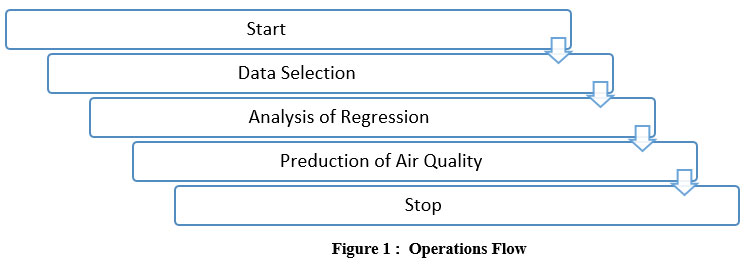 | Figure 1: Operations Flow
|
We refer to it as testing when we apply the model to previously unseen new inputs to evaluate the learned relationship.
Machine learning methods
It is a specific subdivision of artificial intelligence whose purpose is to free the computer from explicit rule programming so that it can learn on its own. A machine learning system can model and forecast the world by finding and understanding underlying patterns in observed data. Supervised algorithms, in contrast to simpler but non-trained unsupervised learning techniques, require human input, output, and feedback during training and reinforcement learning, unsupervised learning, and supervised learning are the three types of machine learning that we use in our methodologies10. The following process represents a step of data analysis that involves modeling to predict air quality.
Linear regression
Every introduction to machine learning should begin with a discussion of linear regression models since they are straightforward but very effective. One important aspect of this approach is that it only takes one numerical value—the ratio of the change in the predictor to the modification in the response—to describe each predictor variable's contribution to the outcome statistic. Because it is assumed that all impacts are linear, this degree of simplicity is achievable.
![]()
or in another word
![]()
The constant term (C), commonly known as the "intercept," represents the value of the response variable when the predictor is equal to zero. The coefficient (B) is a mathematical expression that quantifies the relationship between the change in the reaction and the change in the forecasting factor. Sometimes, people refer to it as a weight or a slope coefficient29.
Decision Tree regression
The most powerful algorithm in machine learning, the decision tree, is also the most straightforward. It is a member of the supervised learning algorithm family. Regression and classification issues can also be resolved with the decision tree method. A decision tree (DT) is progressively created as a result of dividing the dataset into smaller subgroups. Consequently, decision nodes and leaf nodes can be found in the final resultant tree. The algorithm's output is represented by leaf nodes, while decision nodes indicate a condition.
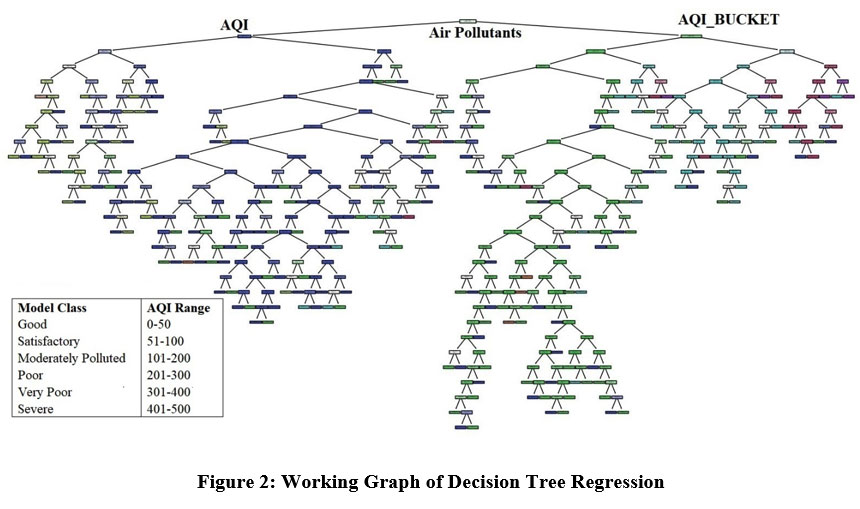 | Figure 2: Working Graph of Decision Tree Regression.
|
Moreover, decision trees are employed in two categories: (i) problems with categorical output and (ii) problems with continuous output. Regression using decision trees is applied to the continuous output problem. The algorithm selects the characteristics of an object and constructs a model using a tree structure. The trained model assists in predicting future data so that the necessary output can be produced. A functional example of decision tree regression is presented in Figure 2.
Random Forest regression
Ensemble learning techniques for classification, regression, and other tasks are called random forests (RFR). Growing classification and regression trees are used to produce the mean prediction of individual trees or the mode of classes after building several decision trees at various training times. The study determines the number of decision trees before training the model. A greater number is preferable in terms of trees, but it requires more computing power. Lower NF values are associated with greater variance reduction and higher bias increase.
Author can use the empirical formula to define NF = /M, where M represents the total number of features. Regression trees or classification trees can use RF to solve both classification and regression problems. Figure 3 also displays the regression model. The final output of the regression model is the following: The model takes into account the presence of regression trees, also known as learners, in the regression prediction process.
![]()
where T denotes the total count of regression trees and hi(x) represents the output of the ith tree tested on sample x. As a result, the average of all the trees' predicted values represents the RF prediction.
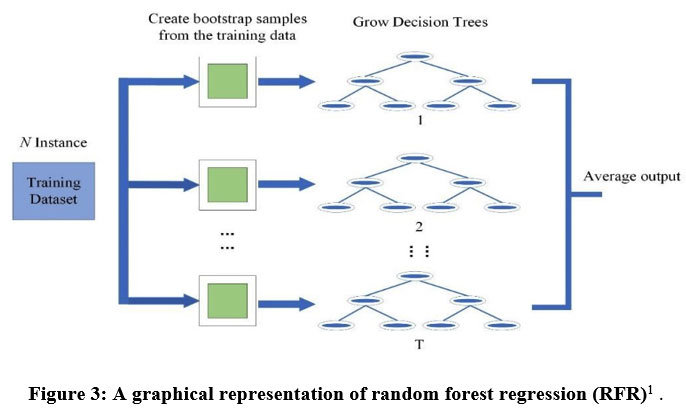 | Figure 3: A graphical representation of random forest regression (RFR) .
|
Extreme gradient boosting (XGBoost)
The process of combining several inefficient classifiers into a single powerful one is referred to as "boosting." The application of Gradient Boosting served as the basis for the development of the XGBoost methodology12. When it comes to computational efficiency, scalability, and generalization performance, the XGBoost version of Gradient Boosting is superior to the original version. When working with XGBoost, proficient data management is of the utmost importance. Due to the fact that XGBoost only accepts numeric vectors as input, all categorical data will be transformed into the numerical values that correspond to them. Using a one-hot encoding is one method that can be utilized to accomplish this transformation. The present investigation is able to acquire the estimated model by employing the universal function, as demonstrated by the form that is presented below:
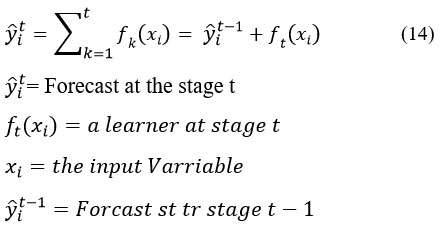
Metrics for performance:
Equation (15, 16) illustrates the two statistical indicators that were used to examine the performance of supervised techniques models.
Root Mean Square Error (RMSE): The term RMSE refers to the square root of the mean squared error. It determines the standard deviation to represent the residual dispersion. It selects an object's attributes and uses a tree's structure to train a model.

The R-squared value evaluates how effectively a linear regression model explains changes in the dependent variable. While it is scale-free, or unaffected by the magnitude of the data, it remains below one. In this case, y is the average value of y, and Y is the estimated amount of y by the equation

Literature Review
Study Title and Reference | Methodology Used | Key Pollutants Predicted | Key Findings |
Over the past fifty years, urbanization, automation, automobiles, power plants, natural activities, and natural occurrences like agricultural burning and wildfires have significantly increased the amount of air pollution14. | Literature Review | General air pollution | Significant increase in air pollution due to multiple factors over the past fifty years. |
A comparative assessment of pre-lockdown and lockdown evidence indicates that widespread use of air pollution measures can lead to immediate improvements in air quality16. | Comparative Assessment | General air pollution | Evidence shows immediate air quality improvement during lockdowns due to reduced activities. |
Machine learning was used to predict SO? levels in Maharashtra (India), but the model unsuccessful to correctly forecast pollution levels in certain cities18. | Machine Learning | SO? | The model failed to accurately predict pollution levels in certain cities in Maharashtra, India. |
There are several literary works available that discuss different machine learning algorithms for modeling and forecasting the air quality index (AQI) and most scientists utilized unsupervised and supervised learning models for predicting AQI, as found by the authors17. | Literature Review of Machine Learning Algorithms | AQI | Various machine learning models, both unsupervised and supervised, are commonly used for AQI prediction. |
The article examines the Air Quality Index (AQI) in Visakhapatnam from 2017 to 2022, revealing an upward trend from 2017 to 2019, followed by a decrease in 2020 due to lockdown, and a continued climb12. | Empirical Analysis | AQI | Upward AQI trend from 2017-2019, decrease in 2020 due to lockdown, and a continued increase afterward. |
The study demonstrates that scholars from Europe, China, and the USA are actively involved in utilizing ML and data mining techniques in the field of air pollution epidemiology. These techniques include DT, (SVMs), K-means clustering, and the “market-based calculation” algorithm19. | Machine Learning and Data Mining Techniques | General air pollution | Various techniques are actively used in air pollution studies by scholars from Europe, China, and the USA. |
The investigation shows that gradient boosting is the best regression model for estimating atmospheric pollution. The study analyzes several machine learning techniques for estimating particulate matter levels, using data from the Taiwan Air Quality Monitoring System collected between 2012 and 201715. | Gradient Boosting and Other Machine Learning Models | Particulate Matter | Gradient boosting is identified as the best model regressor for predicting particulate matter levels using data from Taiwan Air Quality Monitoring System. |
In the western part of India, fewer studies have been carried out on regressor models, such as the XGBoost, K-Neighbour, Random Forest, and Logistic Regressor Decision Tree classifiers. (present) | Literature Review | General air pollution | Limited studies on advanced regressor models like XGBoost, KNeighbour, Random Forest, and Logistic Regressor Decision Tree classifiers in western India. |
During the study period, the mentioned analysis can be used to observe air pollutant concentrations (target) in Rajasthan (India) with the help of independent input data, which are AQI (Air Quality Index) and AQI_Bucket. The AQI_Bucket inputs included the air quality index category. (Present) | Analysis Using Independent Input Data | PM, NO2, Ammonium, SO2, Ozone, Carbon Monoxide | Analysis in Rajasthan (India) uses AQI and AQI_Bucket inputs to observe air pollutant concentrations, including various key pollutants. |
Materials and Methods
The Central Pollution Control Board (CPCB) provided data for eight cities in Rajasthan, i.e., Jodhpur, Kota, Udaipur, Ajmer, Pali, Bhiwandi, and Alwar, for the years 2019–2023. This study measured the concentrations of air pollutants at these locations. The analysis aims to determine the pollution levels in the western part of India before, during, and after the COVID-19 event.
Data Source
The study used air quality data from Udaipur, Jaipur, Ajmer, Alwar, Bhiwandi, Jodhpur, Pali, and Kota cities to assess the air quality of Rajasthan during the pre-lockdown (before), lockdown (during), and post-lockdown (after) phases. This data, received directly from the Central Pollution Control Board web page (https://cpcb.nic.in/), contained measurements of particulate matter, sulfur dioxide, nitrogen dioxide (NO2), carbon monoxide, and ozone (O3).
Data Methodology
Data mining is a process that converts raw data into more easily understandable formats by filling in missing values or reducing data noise. To evaluate models, it is crucial to split datasets into training and testing sets. The testing set, which accounts for 80% of the data, is primarily used for assessment, while the remaining 20% is used for training. This approach helps to elucidate model characteristics and minimize data discrepancies..
Results and Discussion
Variation of AQI Concentration for City
(Pre-lockdown and Lockdown)
The present study used three months of data from the CPCB for the seven pollutants and AQI in the months of March , April and May during a five-year period that included 2019 (before), 2020 (during), and 2021–2023 (after).When comparing pre-lockdown versus lockdown implemented for three months in March, April, and May of 2019 and 2020, cities significantly lowered the AQI values, with maximum and minimum reductions observed in the state of Rajasthan (Fig. 4 and Table 1), particularly in the AQI concentration of Alwar and Jodhpur. The average concentrations of Alwar have dropped by around (-35.6%).The reduction in particle levels was largely due to unexpected local emissions as well as meteorological factors like rainfall and air mass movement
Table 1: Overall variation of percentage change
City | (Pre-lockdown vs Lockdown) | (Lockdown vs Post-lockdown) |
Udaipur | -9.12 | 58.56 |
Pali | 1.65 | 61.72 |
Kota | -13.99 | 75.99 |
Jodhpur | -8.1 | 29.73 |
Bhiwandi | -21.79 | 43.9 |
Alwar | -35.6 | 4.12 |
Ajmer | -22.02 | 16.83 |
Jaipur | 7.2 | 86.77 |
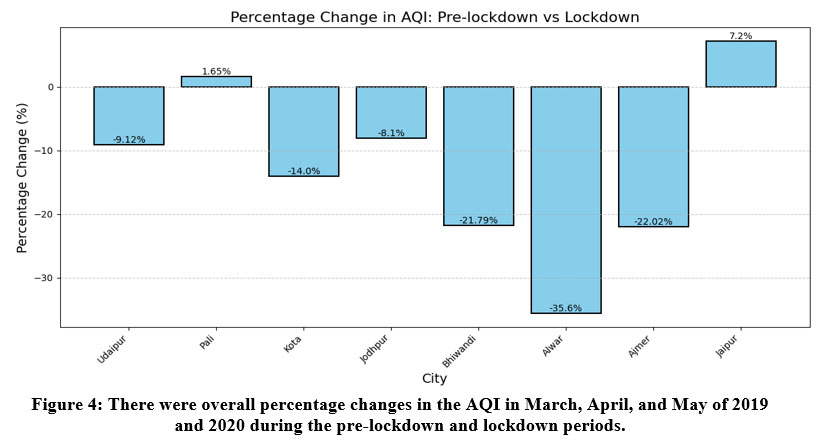 | Figure 4: There were overall percentage changes in the AQI in March, April, and May of 2019 and 2020 during the pre-lockdown and lockdown periods.
|
Figure 5 depicted the study period of 2020 as under lockdown, and the study periods of 2021, 2022, and 2023 as post-lockdown for three months in March, April, and May. During this time, the cities in the state of Rajasthan had significantly higher AQI values for both the maximum and minimum increments (Fig. 5 and Table 1), especially in the AQI concentrations of Jaipur and Alwar. There has been about an 86.77% increase in the average concentrations in Jaipur. Vehicle traffic, low tree density, and excess construction of buildings may increase pollution concentrations in Jaipur
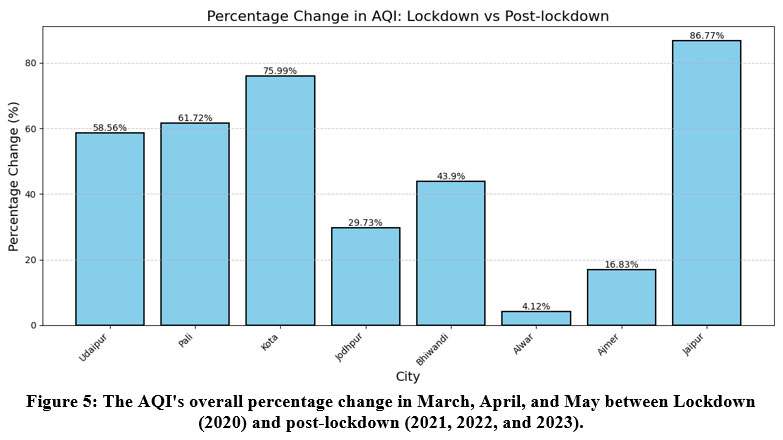 | Figure 5: The AQI's overall percentage change in March, April, and May between Lockdown (2020) and post-lockdown (2021, 2022, and 2023).
|
Deep Learning Study on Air Quality Index and Air Pollutants Using
Stack Model Heat Map (Seaborn).
The Air Quality Index (AQI) study used these three months of data from the CPCB. During the study period, the author collected these months, March, April, and May, over a five-year period that encompassed 2019, 2020, and 2021–2023. As shown in Figures 6, 7, and 8, the contaminants (PM10, PM2.5, NO2, NH3, SO2, O3, and CO) were measured before, during, and after the lockdown. The AQI classification was shown by a Seaborn Pair plot. The AQI class categorization, which uses Python, includes the following values: The range of values includes excellent (0 to 50), acceptable (51 to one 100), moderately polluted (101 to 200), poor (201 to 300), very poor (301 to 400), and severe (> 400).The study displays a correlation between the variable distribution and the AQI. It is clear from the study period that during lockdown, there is a positive correlation between the air pollutants excluded, ozone (O3) and carbon monoxide (CO). PM2.5 and PM10 showed the highest degree of correlation. The results from the pair plot under satisfactory and moderately polluted conditions indicated an development in the air quality in the western part of India. Researchers from around the world
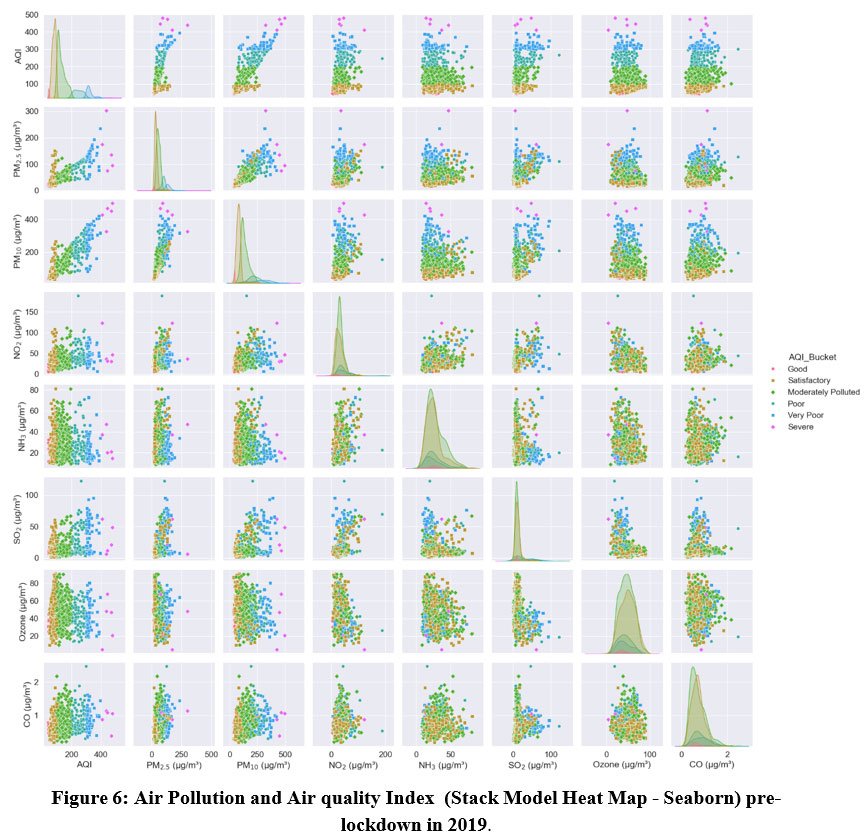 | Figure 6: Air Pollution and Air quality Index (Stack Model Heat Map - Seaborn) pre-lockdown in 2019.
|
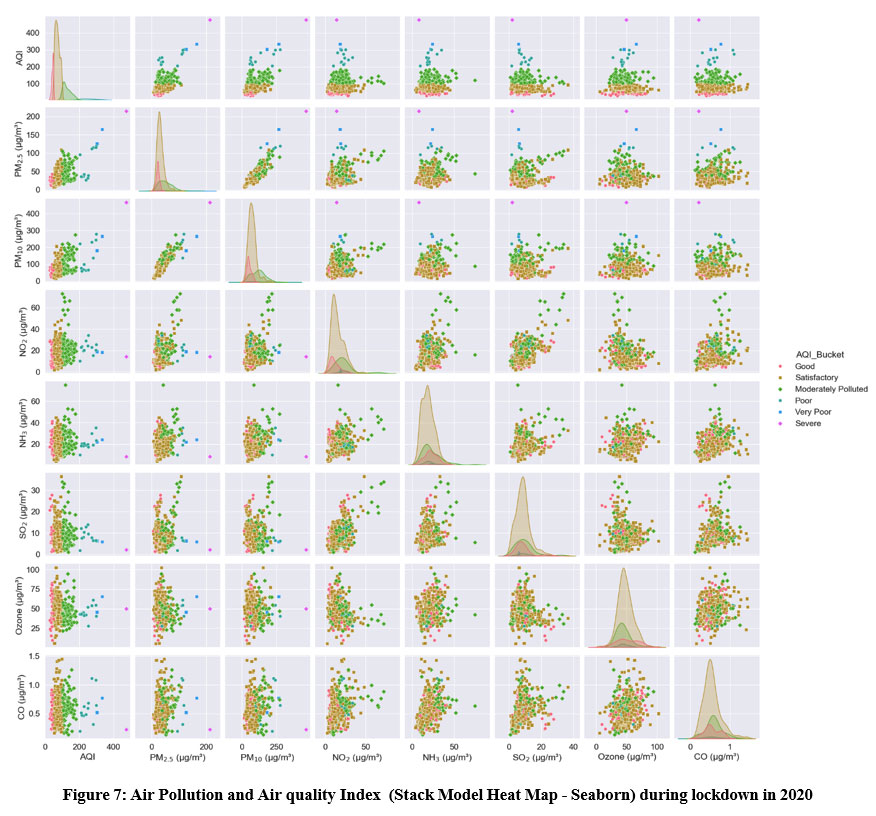 | Figure 7: Air Pollution and Air quality Index (Stack Model Heat Map - Seaborn) during lockdown in 2020.
|
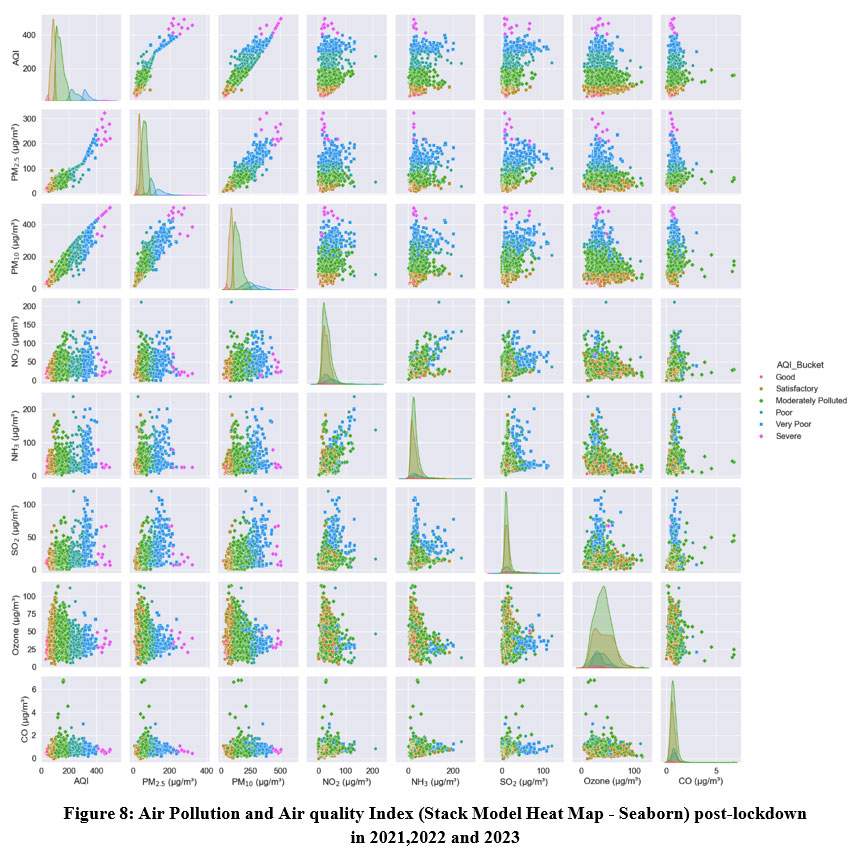 | Figure 8: Air Pollution and Air quality Index (Stack Model Heat Map - Seaborn) post-lockdown in 2021,2022 and 2023.
|
Correlation Matrix
The heat map in Figure 9 graphically illustrates the correlation between all of the attributes used in the air quality dataset. For every value to be plotted, a heatmap has values that represent different shades of the same hue. On a chart, higher values are typically represented by darker hues than lighter ones. Another option is to use an entirely different color for a very different value. The strength of the inter-correlations among the metrics implies that distinct air pollutants influence the AQI. Correlation refers to the mutual relationship between two variables. When one parameter's value increases or decreases, it has a direct correlation with the other. When one parameter rises and the other rises, there is a positive correlation and when one parameter increases and the other's value reduce, there is a negative correlation. The amount ranges from +1 to -1. The connection is considered strong when it falls between +0.8 and 1.0 and -0.8 and -1.0, and moderate between +0.5 and +0.8 and -0.5 and -0.8. The heatmap shows the correlation coefficient value between the parameters. When the correlation falls within these ranges, AQI is positively related to both PM2.5 (0.90) and PM10 (0.91). This demonstrates that PM10 and PM2.5 concentrations directly affect the AQI value. Strong negative correlations exist between the Ozone (O3) (-0.15) and the AQI, as well as between NO2 (-0.19) and both. The primary causes were shown by the quick decline in the ozone titration reaction, which led to a dramatic shift in the association between them at this stage and extremely low NO2 .
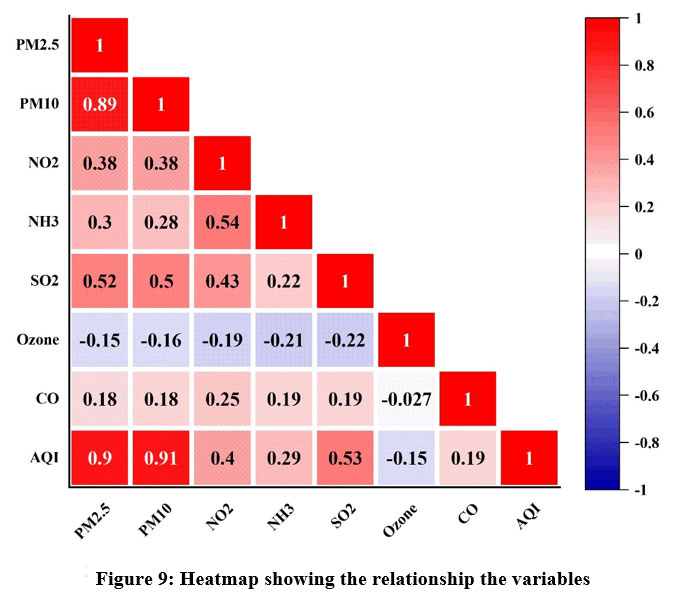 | Figure 9: Heatmap showing the relationship the variables
|
Models Analysis
Model analysis was conducted for accuracy and prediction using Python programming. Using datasets obtained from CPCB website in Rajasthan, the data frame has a range index of 3680. This value was computed from the data.
This information is available on the CPCB, Government of India, official website. The authors standardized the data format and eliminated outliers and null values to preserve good data quality. After removing outliers, null values, and missing values, the dataset which included 3314 points was subjected to (LR), (DTR), (RFR) , (XGBoost) and (KNN) analyses. After data preparation, Table 2 illustrates the summary statistics of the desired variable and the independent variables.
Table 2: Component descriptive statistics
PM2.5 | PM10 | NO2 | NH3 | SO2 | Ozone | CO | AQI | |
count | 3314 | 3314 | 3314 | 3314 | 3314 | 3314 | 3314 | 3314 |
mean | 57.81 | 130.98 | 30.15 | 26.90 | 14.26 | 43.02 | 0.70 | 131.84 |
std | 34.17 | 72.48 | 17.82 | 21.24 | 12.52 | 16.47 | 0.34 | 73.47 |
min | 7.05 | 15.57 | 0.06 | 3.19 | 0.38 | 4.47 | 0.05 | 29 |
25% | 34.78 | 81.27 | 18.16 | 15.38 | 8.07 | 30.80 | 0.51 | 84 |
50% | 49.54 | 112.26 | 27.17 | 23.01 | 10.85 | 42.135 | 0.66 | 109 |
75% | 70.73 | 160.20 | 37.96 | 32.54 | 15.30 | 53.92 | 0.86 | 151 |
max | 322.44 | 739 | 210.93 | 237.34 | 122.18 | 114.6 | 6.77 | 745 |
During the analysis, normalize the data points before dividing the dataset for training and testing. We trained the models using 2651 data points (80%) and tested those using 662 data points (20%) out of a total of 3314 data points. The study used two measurements to check how well the model could predict.i.e., RMSE and R2. These were based on the actual and predicted values.
Table 3: Dependent Air pollutants and Independent AQI Model’s Effectiveness
Performance Indices | Training Data | Testing Data | ||||||
Model | LR | DTR | RFR | XGBoost | LR | DTR | RFR | XGBoost |
RMSE | 27.48 | 7.67 | 11.47 | 8.47 | 24.09 | 28.18 | 19.22 | 18.87 |
R2 | 0.86 | 0.98 | 0.97 | 0.98 | 0.88 | 0.83 | 0.92 | 0.92 |
Accuracy(%) | 86 | 98 | 97 | 98 | 88 | 83 | 92 | 92 |
This study used models and metrics from CPCB data to evaluate the model's performance. Table 3 provides these metrics. Author conduct a comparative study for the appropriate five-year pre-lockdown (2019), lockdown (2020), and post-lockdown (2021–2023) periods of March, April, and May.
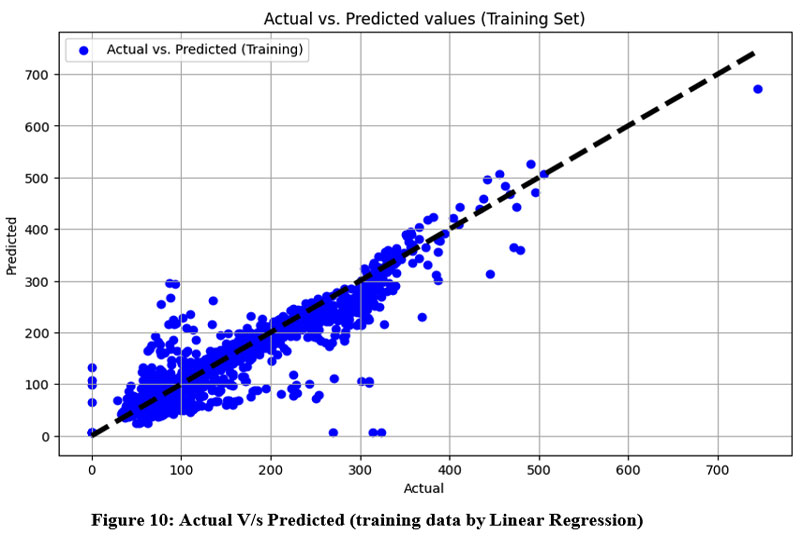 | Figure 10: Actual V/s Predicted (training data by Linear Regression)
|
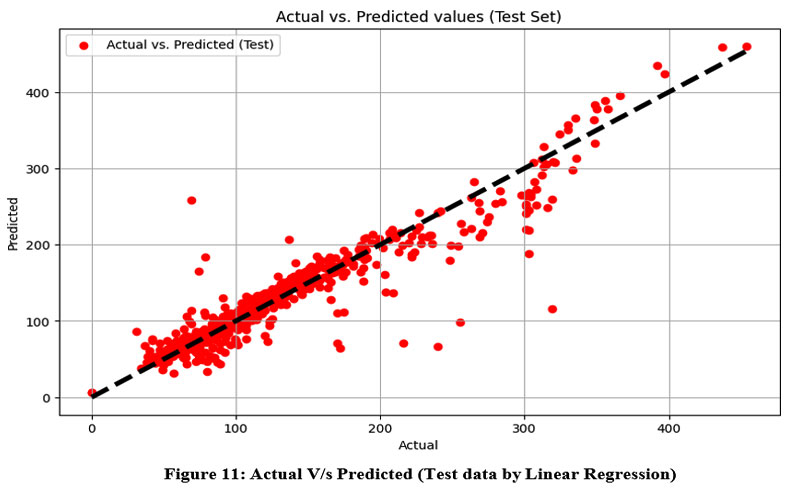 | Figure 11: Actual V/s Predicted (Test data by Linear Regression)
|
A linear regression analysis is depicted in Figures 10-11, where the independent variable is the AQI for model accuracy, and the dependent variable is an air pollutant. With a random state of 70, the data used comprised 80% training and 20% test data. The R2 values for the training and testing datasets are closer to the straight line (0.86, 0.88) at their highest points, as observed in the graph between the actual AQI values and predicted values. We can infer that the model's R2 value is closer to one, indicating its effectiveness in most cases and clear depiction of trends (86.00 to 88.00).
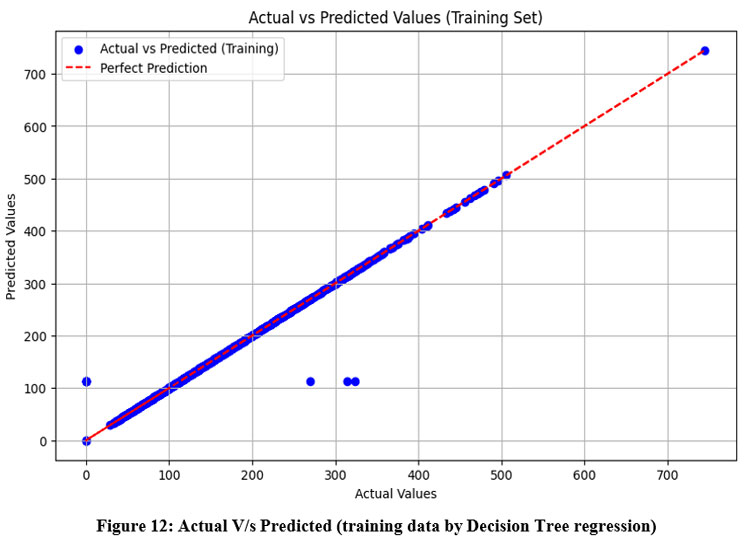 | Figure 12: Actual V/s Predicted (training data by Decision Tree regression)
|
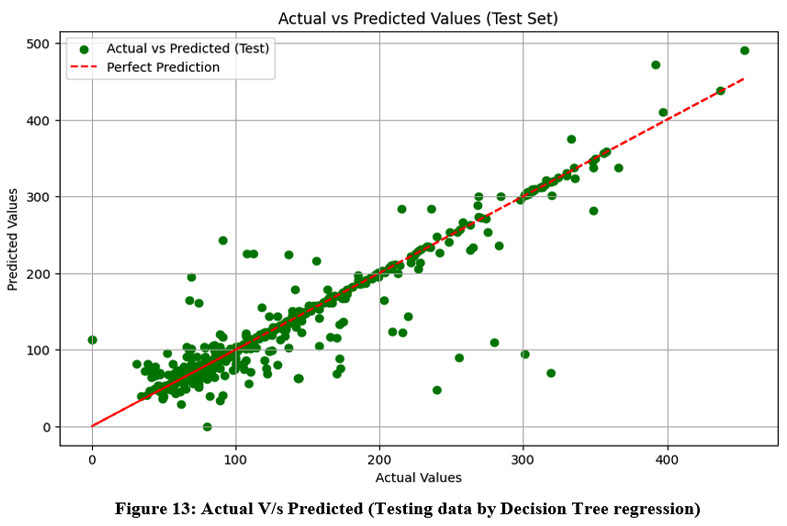 | Figure 13: Actual V/s Predicted (Testing data by Decision Tree regression).
|
Figures 12–13 display the results of a decision tree regression study in which air pollutants are the experimental variable and the aqi is the manipulated variable used to measure the model's correctness. It utilized 80% of the data for training and 20% for testing, with a random state value of 70. The graph comparing the actual AQI to the predicted AQI for both training and testing data indicates that Decision Tree Regression (0.98, 0.83) yields the highest R2 responses close to the straight line. This suggests that the model performs effectively in most cases and clearly depicts trends.
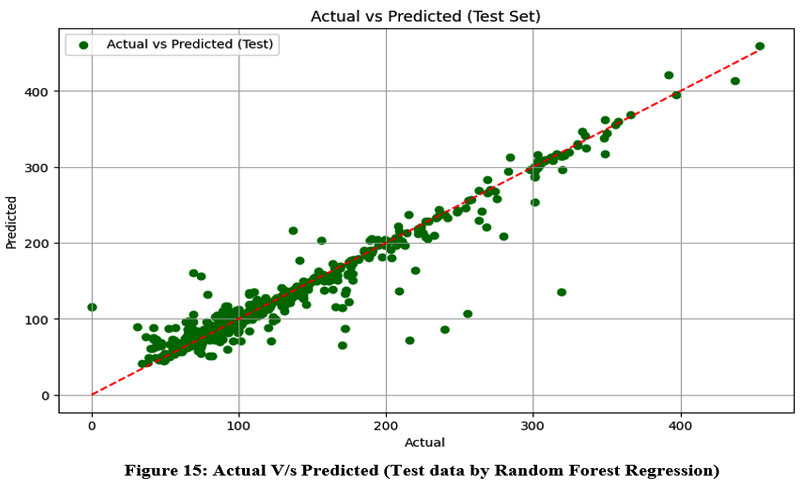 | Figure 14: Actual V/s Predicted (training data by Random Forest Regression).
|
.jpg) | Figure 15: Actual V/s Predicted (Test data by Random Forest Regression).
|
Figures 14–15 depict a random forest regression study with an air pollutant as the response variable and AQI as the explanatory variable for model validity. In this study, the author used a random state of 70. The maximum responses of R2 for the training and testing datasets in random forest regression (0.97, 0.92) are closer to the straight line on the graph representing the actual versus predicted AQI. This shows that the model has an R2 value closer to one, signifying its satisfactory performance in many cases and its ability to display trends nicely with adequate accuracy of the model (97.00, 92.00).
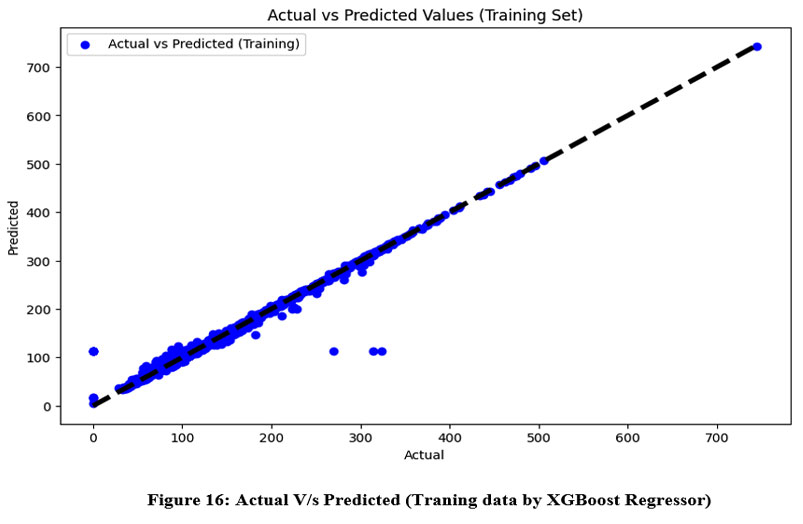 | Figure 16: Actual V/s Predicted (Traning data by XGBoost Regressor).
|
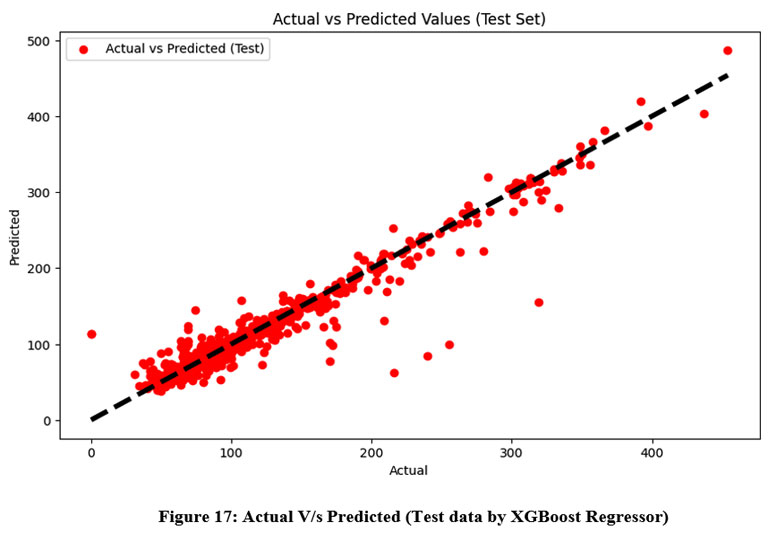 | Figure 17: Actual V/s Predicted (Test data by XGBoost Regressor)
|
Figures 16–17 depict an Extreme gradient boosting regressor study with an air pollutant and AQI for model validity. The maximum responses of R2 for the training and testing datasets in random forest regression (0.98, 0.92) are closer to the straight line on the graph representing the actual versus predicted AQI for both datasets. This indicates that the model has an R2 value closer to one, signifying its satisfactory performance in many cases and its ability to display trends nicely with adequate accuracy of the model (98.00, 92.00). The errors for linear regression (LR) are shown in Table 3, along with the root mean square error values for the train and test datasets (27.48 and 24.09, respectively). Similarly, the study obtain errors for Decision Tree Regression (DTR), which include RMSE values for both datasets (7.67, 28.19). In Addition, the study also get errors for Random Forest Regression (RFR), with RMSE values of 11.47 and 19.22 datasets, respectively. However, extreme gradient boosting (XGBoost) found that the minimum root mean square error for both datasets was 8.47 and 18.87.
In the study period, it was found that extreme gradient boosting regression analysis demonstrates superior performance compared to linear regression (86.00, 88.00), decision tree regression (98.00, 83.00), and random forest regression (97.00, 92.00) in terms of accuracy for both the training and testing datasets (98.00, 92.00). Therefore, we consider it a suitable framework for evaluating the accuracy of Rajasthan's air quality, as it shows minimal RMSE errors without any instances of under- or over-fitting.
Table 4: Dependent Air pollutants and Independent AQI_Bucket Model’s Effectiveness
Model | Training Data | Testing Data | Kappa Score |
Logistic Classifier (LC) | 0.66 | 0.66 | 0.45 |
Decision Tree Classifier (DTC) | 0.99 | 0.89 | 0.83 |
Random Forest Classifier (RFC) | 0.99 | 0.92 | 0.88 |
Extreme gradient boosting Classifier (EGBC) | 0.99 | 0.93 | 0.89 |
K- Nearest Neighbor Classifier (KNNC) | 0.92 | 0.86 | 0.77 |
The training and testing accuracies of each classifier are provided in Table 4. The Extreme gradient boosting and the Random Forest Classifier are achieved the best results across all datasets, with scores of 99% in the training data and (92.00 , 93.00) in the testing data respectively. Conversely, the logistic classifier yielded training and testing scores of 66% respectively, predicting the worst outcomes. Additionally, KNN classifiers obtained 92% accuracy in the training dataset and 86% in the testing dataset and Decision tree classifier found 99% training data with 89% of testing datasets . The best-performing classifier among the five datasets in Table 4 is the Extreme gradient boosting Classifier. Furthermore, we observe that AQI accuracy and prediction results are satisfactory when feature selection is utilized.
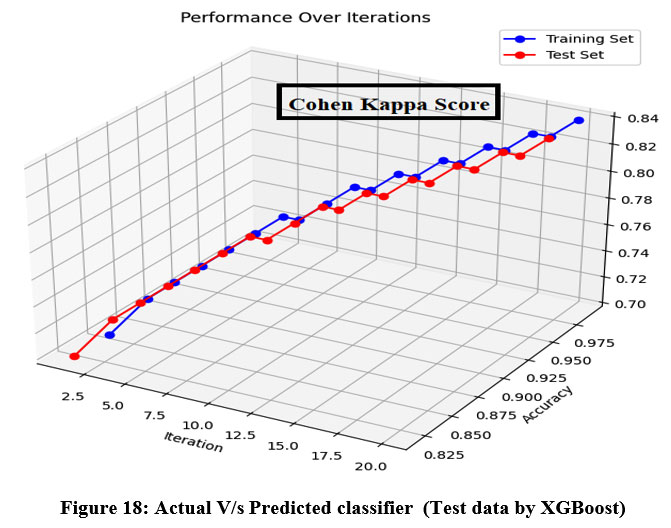 | Figure 18: Actual V/s Predicted classifier (Test data by XGBoost)
|
The actual vs. predicted classifier is depicted in Figure 18. The highest Kappa score for random forest regression during the study period was 0.89. As a result, Extreme gradient boosting emerges as the most effective model for predicting AQI.
Conclusion
The following conclusions have been reached from the overall results and discussion:
Alwar exhibited the largest percentage deduction in AQI whereas Jodhpur had the lowest reduction among the mentioned location during Pre-lockdown and Lockdown period.
According to the study's findings, which utilized Pearson correlation analysis, there is a significant relationship between AQI and PM levels. However, there was only an insignificant connection among the Air Quality Index (AQI) and Ozone .
Extreme gradient boosting got accuracy scores of 98.00% for the training dataset and 92.00% for the testing dataset. This is much higher than the 86.00% and 88.00% for linear regression, 98.00% and 83.00% for decision tree regression, and 97.00% and 92.00% for random forest regressors.
In this study period, the model found a maximum kappa score of 0.89 for the air quality index (AQI) model prediction using an extreme gradient boost.
Acknowledgment
We thank the Central Pollution Control Board (India) for providing the data for this study.
Funding source
The authors did not received support from any agency for this study or research work
Conflict of Interest
The authors declare that they have no known competing financial interests or personal relationships that could have appeared to influence the work reported in this paper.
Data Availability Statement
Data available publicly at https://airquality.cpcb.gov.in/ccr/#/caaqm-dashboard-all/caaqm-landing
Ethics Statement
This research did not involve human participants, animal subjects, or any material that requires ethical approval.
Authors’ Contribution Statement
Mr. Vikram Singh Bhati: Writing original draft; Writing - review & editing; Figure preparation; Formal analysis.
Dr. Abhishek Saxena: Conceptualization; Investigation; Methodology; Software; Writing original draft
Dr. Ravi Khatwal: English Writeup, Logical thinking
Reference
- Liu H, Li Q, Yu D, Gu Y. Air quality index and air pollutant concentration prediction based on machine learning algorithms. Appl Sci. 2019;9(19):4069.
CrossRef - Sahoo PK, Mangla S, Pathak AK, Salãmao GN, Sarkar D. Pre-to-post lockdown impact on air quality and the role of environmental factors in spreading the COVID-19 cases: a study from a worst-hit state of India. Int J Biometeorol. 2021; 65:205-222.
CrossRef - Mahato S, Talukdar S, Pal S, Debanshi S. How far climatic parameters associated with air quality induced risk state (AQiRS) during COVID-19 persuaded lockdown in India. Environ Pollut. 2021; 280:116975.
CrossRef - Guttikunda SK, Dammalapati SK, Pradhan G, Krishna B, Jethva HT, Jawahar P. What is polluting Delhi’s air? A review from 1990 to 2022. Sustainability. 2023;15(5):4209.
CrossRef - Suroshe S, Dharpal SV, Ingole NW. Prediction of air quality index using regression models. GIS Sci J. 2022;9(8):576-591.
- Julfikar SK, Ahamed S, Rehena Z. Air quality prediction using regression models. In Applications of Artificial Intelligence and Machine Learning. ICAAAIML 2020; 2021:251-262.
CrossRef - Ikhlasse H, Benjamin D, Vincent C, Hicham M. Environmental impacts of pre/during and post-lockdown periods on prominent air pollutants in France. Environ Dev Sustain. 2021;23(9):14140-14161.
CrossRef - Xu Y, Liu X, Cao X, et al. Artificial intelligence: A powerful paradigm for scientific research. The Innovation. 2021;2(4).
CrossRef - Goodfellow I, Bengio Y, Courville A. Deep Learning. MIT Press; 2016.
- Saravanan R, Sujatha P. A state of art techniques on machine learning algorithms: a perspective of supervised learning approaches in data classification. In 2018 Second International Conference on Intelligent Computing and Control Systems (ICICCS). IEEE; 2018:945-949.
CrossRef - Hope TM. Linear regression. In Machine Learning. Academic Press; 2020:67-81.
CrossRef - Ravindiran G, Hayder G, Kanagarathinam K, Alagumalai A, Sonne C. Air quality prediction by machine learning models: a predictive study on the Indian coastal city of Visakhapatnam. Chemosphere. 2023; 338:139518.
CrossRef - Sunku VSRP, Mukkamala R, Namboodiri V. Air quality index prediction using multivariate deep neural networks: a case study of a proposed state capital in India. Journal of Air Pollution and Health. 2023;8(3).
CrossRef - Jung CR, Hwang BF, Chen WT. Incorporating long-term satellite-based aerosol optical depth, localized land use data, and meteorological variables to estimate ground-level PM2.5 concentrations in Taiwan from 2005 to 2015. Environmental Pollution. 2018; 237:1000-1010.
CrossRef - Harishkumar KS, Yogesh KM, Gad I. Forecasting air pollution particulate matter (PM2.5) using machine learning regression models. Procedia Computer Science. 2020; 171:2057-2066.
CrossRef - Kumari S, Lakhani A, Kumari KM. COVID-19 and air pollution in Indian cities: world’s most polluted cities. Aerosol and Air Quality Research. 2020;20(12):2592-2603.
CrossRef - Patil RM, Dinde HT, Powar SK, Ganeshkhind PM. A literature review on prediction of air quality index and forecasting ambient air pollutants using machine learning algorithms. Int J Innov Sci Res Technol. 2020;5(8):1148-1152.
CrossRef - Bhalgat P, Pitale S, Bhoite S. Air quality prediction using machine learning algorithms. International Journal of Computer Applications Technology and Research. 2019;8(9):367-370.
CrossRef - Bellinger C, Mohomed Jabbar MS, Zaïane O, Osornio-Vargas A. A systematic review of data mining and machine learning for air pollution epidemiology. BMC Public Health. 2017; 17:1-19.
CrossRef - Yadav R, Vyas P, Kumar P, Sahu LK, Pandya U, Tripathi N, Gupta M, Singh V, Dave PN, Rathore DS, Beig G. Particulate matter pollution in urban cities of India during unusually restricted anthropogenic activities. Frontiers in Sustainable Cities. 2022; 4:792507.
CrossRef - Ruhela M, Maheshwari V, Ahamad F, Kamboj V. Air quality assessment of Jaipur city Rajasthan after the COVID-19 lockdown. Spatial Information Research. 2022;30(5):597-605.
CrossRef - Pacheco H, Díaz-López S, Jarre E, Pacheco H, Méndez W, Zamora-Ledezma E. NO2 levels after the COVID-19 lockdown in Ecuador: a trade-off between environment and human health. Urban Climate. 2020; 34:100674.
CrossRef - Menut L, Bessagnet B, Siour G, Mailler S, Pennel R, Cholakian A. Impact of lockdown measures to combat Covid-19 on air quality over western Europe. Science of the Total Environment. 2020; 741:140426.
CrossRef - Chen LWA, Chien LC, Li Y, Lin G. Nonuniform impacts of COVID-19 lockdown on air quality over the United States. Science of the Total Environment. 2020; 745:141105.
CrossRef - Pei Z, Han G, Ma X, Su H, Gong W. Response of major air pollutants to COVID-19 lockdowns in China. Science of the Total Environment. 2020; 743:140879.
CrossRef - Nakada LYK, COVID RU. Pandemic: impacts on the air quality during the partial lockdown in São Paulo state, Brazil. Science of the Total Environment. 2020; 730:139087.
CrossRef - Pusede SE, Steiner AL, Cohen RC. Temperature and Recent Trends in the Chemistry of Continental Surface Ozone. Chem Rev. 2015;115(10):3898-3918.
CrossRef - Wang L, Wang J, Fang C. Assessing the impact of lockdown on atmospheric ozone pollution amid the first half of 2020 in Shenyang, China. International Journal of Environmental Research and Public Health. 2020;17(23):9004.
CrossRef - Taghinezhad E, Kaveh M, Szumny A, Figiel A. Quantifying of the best model for prediction of greenhouse gas emission, quality, and thermal property values during drying using RSM (Case Study: Carrot). Applied Sciences. 2023;13(15):8
CrossRef - Sahu LK. Volatile organic compounds and their measurements in the troposphere. Curr Sci. 2012;102(11):1645-1649.
- Lefohn AS, Wernli H, Shadwick D, Limbach S, Oltmans SJ, Shapiro M. The importance of stratospheric–tropospheric transport in affecting surface ozone concentrations in the western and northern tier of the United States. Atmos Environ. 2011;45(28):4845-4857
CrossRef







